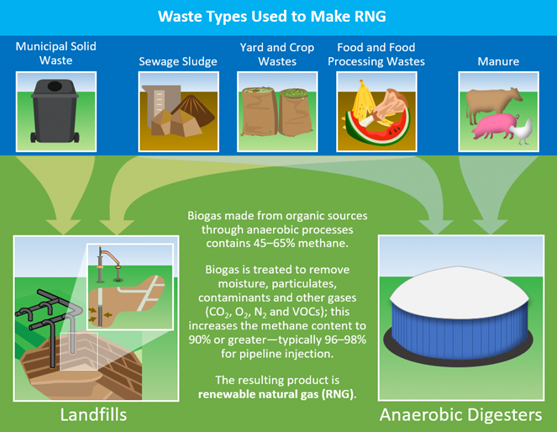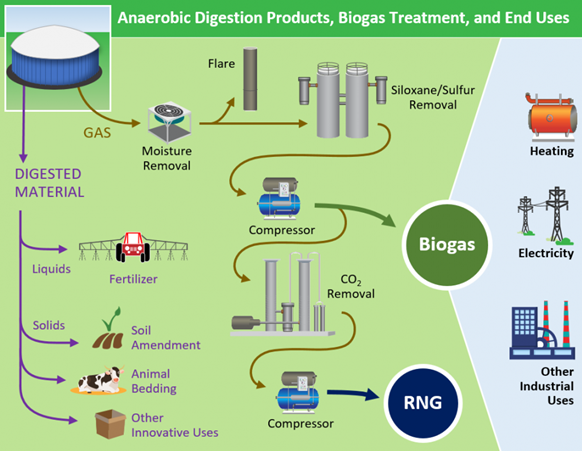Renewable natural gas (RNG), also known as biogas, is a form of natural gas produced from organic waste material rather than underground wells. It is a clean form of energy that is interchangeable and placed into the natural gas systems. RNG is often captured during biomass processing (such as compost, landfills, wastewater processing, or anaerobic digesters), and requires little purifying to create a high-methane, efficient fuel.
Production of RNG through Anaerobic Digesters
RNG is a naturally occurring gas created from decomposing organic matter. Production of RNG can be enhanced and collected into a closed system through an anaerobic digester (AD).
An AD is a biomass processor that facilitates an oxygen-deprived environment for bacteria to break down organic material such as manure, wastewater, and landfills and capture the resulting methane.
Natural gas and electricity are two of the possible end products for ADs. Additionally, the solid byproduct of ADs is reusable in feed, fertilizer, and animal bedding. Because of this continuous cycle of use and come from renewable resources like the dairy and hog industries, anaerobic digesters are highly efficient processors with multiple products.

image credit: https://www.epa.gov/lmop/renewable-natural-gas
Anaerobic Digesters in Indiana
There are approximately 10 anaerobic digesters in Indiana; some locations host more than one digester at a single site.
Anaerobic digesters in Indiana are often located on hog, cattle, and dairy farms to reduce the transport distance from the source to the digester. Some digesters co-digest non-livestock waste like restaurant grease, discarded oils and fats, agricultural reside, and food waste.
| Indiana AD Statistics | ||||||
|---|---|---|---|---|---|---|
| From AgSTAR Livestock Anaerobic Digester Database https://www.epa.gov/agstar/livestock-anaerobic-digester-database | ||||||
| Company Name | Plant Location | Animal Types | Co-digestion | Electricity Generated | Biogas Production | # of Employees |
| Bio Town Ag | Reynolds | 4500 cattle, 1600 swine | Yes | 70,364,700 kWh/yr | N/A | 14 |
| Bos Dairy Digester | Fair Oaks | 3600 dairy | No | |||
| Green Cow Power | Goshen | 1500 dairy | Yes | 907,200 ft3/day | ||
| Herrema Dairy Digester | Fair Oaks | 3750 dairy | No | |||
| Hidden View Digester | Rensselaer | 3500 dairy | No | 7,073,700 kWh/yr | ||
| Homestead Dairy Digester | Plymouth | 2100 dairy | Fats, oils, greases | 7,446,000 kWh/yr | ||
| Prairie’s Edge Dairy Site 2, Digester 1 | Fair Oaks | 12000 dairy | No | 7,818,300 kWh/yr | 1,200,000 ft3/day | |
| Prairie’s Edge Dairy Site 2, Digester 1 | Fair Oaks | 4300 dairy | No | |||
| Waste No Energy Digester | Monticello | 300 cattle, 8000 swine | Agricultural Residues; Fats, Oils, Greases; Food Processing Wastes; Food Wastes | 8,370,000 kWh/yr | 408,000 ft3/day | |
| Windy Ridge Dairy Digester | Fair Oaks | 7000 animals | No | |||

image credit: https://www.epa.gov/lmop/renewable-natural-gas
